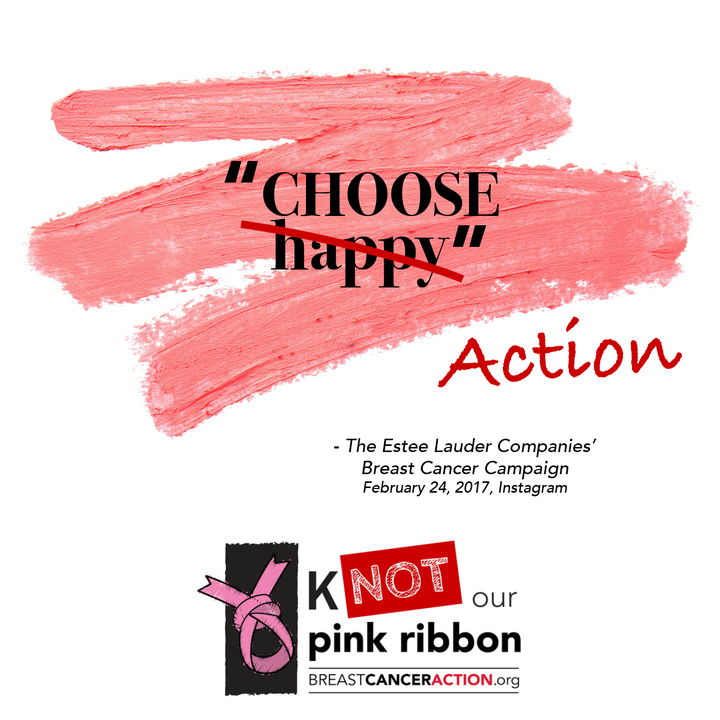
On the 25th anniversary of the pink ribbon, many women with first-hand experience with breast cancer are not celebrating—far from it. Frustrated by the barrage of cheerful, pink marketing that feels so far removed from our lived realities, many of us are angry about the misrepresentation and misinformation that gets spread in the name of “awareness.” We’re angry that after 25 years of pink ribbon awareness and billions of dollars spent on pink ribbon products, there is too little to show. And we’re angry about the exploitation of the disease for profit.
Breast cancer has become the darling of corporate America and the pink ribbon is one of the most widely recognized symbols. Breast cancer awareness has ballooned into a multibillion-dollar industry with companies using the pink ribbon to sell their products and boost their image—which of course boosts their bottom line. It’s one reason the national education and activist group that I lead, Breast Cancer Action, has long called October “Breast Cancer Industry Month.”
This October marks 25 years since the global cosmetics corporation Estée Lauder helped launch the pink ribbon. And we are calling out Estée Lauder for 25 years of betrayal.
Estée Lauder has built their brand around their self-proclaimed “commitment” to breast cancer. They congratulate themselves on distributing more than 150 million pink ribbons at their beauty counters and illuminating more than 1,000 landmarks around the world pink “to raise awareness.” They even hold the Guinness World Record for “Most Landmarks Illuminated for a Cause in 24 Hours.” But in our book, the only record they hold is longest running empty awareness campaign.
Awareness as an end in itself, removed from a call to action, isn’t useful. Everyone in the U.S. is aware of breast cancer. And awareness hasn’t changed the facts. More than a quarter of million women are diagnosed with breast cancer each and every year. More than 40,000 women still die from the disease annually. And women of color and underserved communities fare worse and bear a disproportionate burden of the disease. Pink illuminated landmarks do nothing to change that—and won’t help Estée Lauder’s stated mission to “create a “breast cancer-free world.”
Estée Lauder crows: “25 years ago, there was no pink ribbon.” But their version of history erases the fact that there was a peach one. A ribbon designed by grassroots activist, Charlotte Haley, which focused attention on breast cancer prevention and political action. When Estée Lauder and Self magazine combined forces and approached Haley about “partnering” to distribute a breast cancer ribbon, she recognized the danger of her agenda getting hijacked and declined, saying they were “too corporate” for her. Not to be deterred, Estée Lauder and Self turned the peach ribbon pink, and also turned the focus to marketing, awareness, and corporate gain. Just as Estée Lauder hijacked a grassroots tool, turning it pink, today pink ribbons have themselves hijacked the movement replacing the women they were intended to help.
Perhaps nothing shows this more than the fact that Estée Lauder’s shameless encouragement this year for women to buy their “Advanced Night Repair” cream—which comes with a collectable Pink Ribbon Keychain—and contains the hormone disruptor octinoxate. Estée Lauder tells us to buy their products because they care about breast cancer. But their products contain a number of chemicals of concern that may increase the risk of breast cancer and interfere with treatment. We call this pinkwashing.
Estée Lauder sells a lot of things during October. In addition to pushing their pinkwashed products, they push a positive lifestyle with tips like “choose happy,” “laugh often,” and “smile”—because “Having gratitude and a positive attitude can always help.” Estée Lauder seems to be telling us that with the right attitude and beauty products, we can all become better, more beautiful breast cancer patients. Instead of suggesting that women’s attitudes are to blame for their breast cancer, Estée Lauder needs to make sure the ingredients in their products don’t contribute to increased risk of breast cancer and interfere with breast cancer treatments. The truth is no amount of positive thinking will prevent women from being diagnosed with or dying from breast cancer—but eliminating exposures to chemicals of concern might.
Women at risk and living with breast cancer deserve better. After 25 years, Breast Cancer Action is calling on Estée Lauder to stop the betrayal and be honest that empty awareness cannot “create a breast cancer-free world;” that positive thinking cannot prevent a woman from being diagnosed with or dying from breast cancer; and to be honest about the chemicals of concern in their products and commit to the highest standards to protect women’s health.
We have too little progress to show in the way of breast cancer treatment, prevention, survival, and inequities, despite the billions of dollars spent on pink ribbon products. This isn’t a time for celebration. It’s a time for anger. It’s a time for action.
